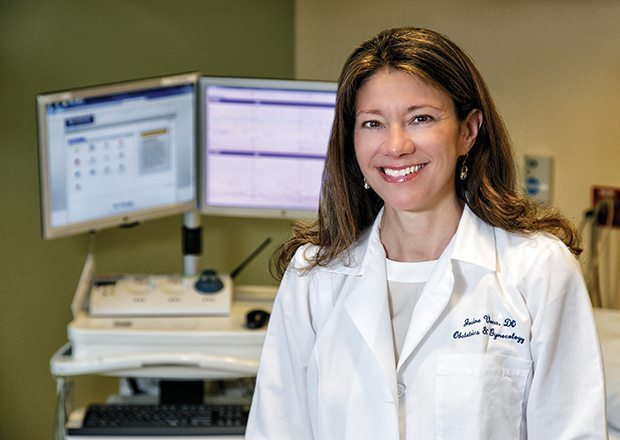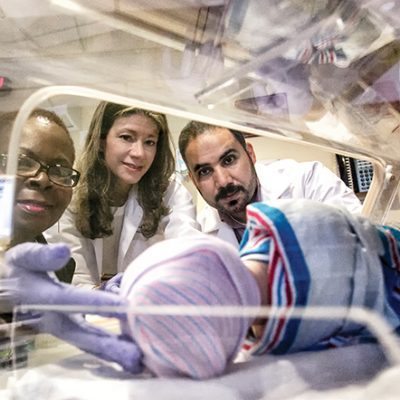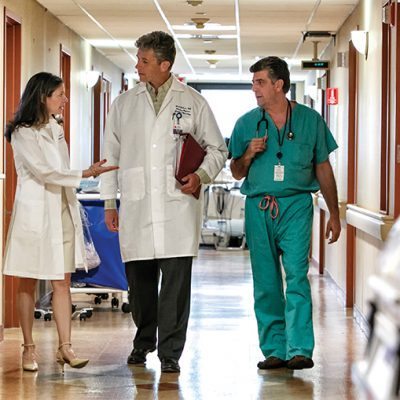
An attending physician at New York Methodist Hospital describes the art and science of Obstetrics and Gynecology
BY MEGAN SCHADE • Photos By amessé photography
Who wouldn’t want to work at the best hospital in Brooklyn?” laughed Josine Veca, D.O., an attending physician in New York Methodist Hospital’s (NYM) Department of Obstetrics and Gynecology. “I came here for my residency, and I never left. At NYM, I am able to help women from so many different backgrounds, with such a range of conditions, and am able to offer them the best healthcare services the city has to offer. Why would I go anywhere else?”
Though the words obstetrics and gynecology are frequently used as a single unit, each is its own distinct field of practice. Obstetrics involves the health of a woman and her developing child throughout pregnancy, birth and the postpartum period. Gynecology involves issues surrounding a woman’s reproductive system.
Dr. Veca was drawn to obstetrics and gynecology at an early age. “When I was a teenager, I was present when my older sister gave birth, and that had a tremendous impact on me. And I loved the idea of taking care of people. It was something that seemed very familiar since I grew up in a family with six children.”
She went on to receive her medical degree at the New York College of Osteopathic Medicine and completed a residency and internship at New York Methodist in obstetrics and gynecology. “One thing unique to this field is that you see women over the course of many years—from adolescence through pregnancy and childbirth, and then later through menopause and the years that follow. We have the ability to develop relationships over time, and the result is a level of comfort in talking about issues that might be fairly intimate.”
“A patient may come to see me, or another doctor in the NYM women’s health practice, as a young woman who is having difficult menstrual cycles, or painful intercourse or difficulty in getting pregnant. I do an evaluation of the patient and we decide on a course of action or treatment. Sometimes that might mean referral to a specialist in an area like minimally invasive gynecological surgery or reproductive endocrinology. We have a great group of specialists in all areas of obstetrics and gynecology, so I know that if I do make a referral, my patients will be in good hands.
“There are some women I don’t see often but I do remind them to come in and let me check their health markers: the pap smears to check for cervical cancer, or the mammogram to check for breast cancer—and that’s okay, too—just as long as they do it!”
When a woman becomes pregnant, she seamlessly enters the other branch of Dr. Veca’s practice: obstetrics. “Delivering babies is generally a very happy field of medicine to practice,” she said. As the pregnancy progresses, “I monitor the developing fetus, but also make sure that the mom is doing well. Pregnancy is a truly amazing process, but it can also be hard on the mother. Her body is funneling all of her resources towards the growing fetus, and the associated hormonal changes can be challenging. Not only am I there to support her physical health, I also try to support her emotionally.”
“Dr. Veca’s dedication to her patients is admired by all of her Hospital colleagues,” said Sanford Lederman, M.D., chairman of obstetrics and gynecology at NYM. “It is obvious why her patients adore her.” Dr. Veca says that a great benefit of practicing in the NYM women’s health practice is the proximity of services, including the Advanced Women’s Imaging and Prenatal Testing Center, led by Natan Haratz, M.D. The Center offers a wide array of ultrasound tests, such as nuchal fold determination, fetal echocardiography, and multiple pregnancy evaluations as well as a number of gynecologic tests; and laboratory tests, including fetal cell-free DNA determination, chorionic villus sampling, and amniocentesis. Should a pregnancy be considered high risk, the mother is seen in the Division of Maternal Fetal Medicine, led by Dr. Lederman and Jacqueline Bush, M.D.
When it is time for a woman to give birth, NYM’s labor and delivery unit offers a family-centered birth experience. Expecting mothers also have the reassurance that, if needed, the high-tech medical equipment and the specialists essential for administering emergency treatment are immediately accessible. Three 24-hour operating rooms, used exclusively for obstetrics, are located within the maternity unit. “In addition, we have a fantastic team of labor and delivery nurses and midwives on our staff. Quite honestly, I don’t know what we would do without them,” said Dr. Veca.
“I deliver nearly 200 babies a year,” said Dr. Veca. “Birth is a time of tremendous joy. Being there to assist and treat a woman through the nine months of pregnancy and then help her deliver the baby is extremely gratifying. Yet, sometimes joy is tempered with caution. A baby may be born prematurely, or need to be rushed into surgery. But I know that we have one of the best Level III neonatal intensive care units in the country.”
Although pregnancy ends with birth, the need for gynecologic health lasts a lifetime. “Menopause signals the end of a woman’s childbearing years,” Dr. Veca said. “For many women, menopause is a relief because they no longer need to worry about becoming pregnant, but menopause can also bring some not-so-pleasant hormonal side effects, such as hot flashes and night sweats. I work with many women to help control the symptoms of menopause as much as possible so that they will be ore comfortable during an often challenging time.
“Sometimes, a condition can be gynecologic but also involve another special area of gynecology. For instance, in cases where they may be a prolapse (relaxation or dropping) of organs related to the urinary tract, I refer the patient to Marisa Mastropietro, M.D., the urogynecologist on our staff, and we work closely together on the case.
And while it doesn’t happen often, a patient may have symptoms that are consistent with certain types of cancer. I am able to refer them to Katherine Economos, M.D., or Constantine Gorelick, M.D., in NYM’s Division of Gynecologic Oncology. I think it brings the patient comfort to know that, during a stressful time, they are going to specialists who are part of our same Department.”
Facing page, top: Dr. Veca discusses patients with staff on the labor and delivery unit. From left: Ashley Francis, RN, Leslie Bizovi, M.D., Dr. Veca, Mahino Talib, M.D., Ashley Bartalot, M.D., Brandon Bell, M.D., and Donna Pynn, CNM . Facing page, bottom: Sanford Lederman, M.D., chairman of the Department of Obstetrics and Gynecology, joins Dr. Veca in welcoming a patient to the labor and delivery unit This page, top: Martha Sanderson, RNC, Dr. Veca, and Ashraf Gad, M.D., neonatologist, assess a newborn This page, bottom: Dr. Veca reviews patients’ conditions with the labor and delivery nurses. From left: Kayann Stephens, RN, Beverly Clarke, RN, Laura Coogan, RN, Dr. Veca, and Nicole James, RN.
“I get to work with patients as they progress through the stages of their life, from their teens to childbearing years, through menopause and for many years thereafter. When patients have health issues, I enjoy caring for them and treating them during those times. Once, I delivered a set of quadruplets—three girls and a boy! Not many doctors ever get to do that!”
New York Methodist Hospital
506 Sixth Street / 718.780.3000 / nym.org








